湘少版小学英语知识点归纳集锦.
- 格式:doc
- 大小:13.00 KB
- 文档页数:4
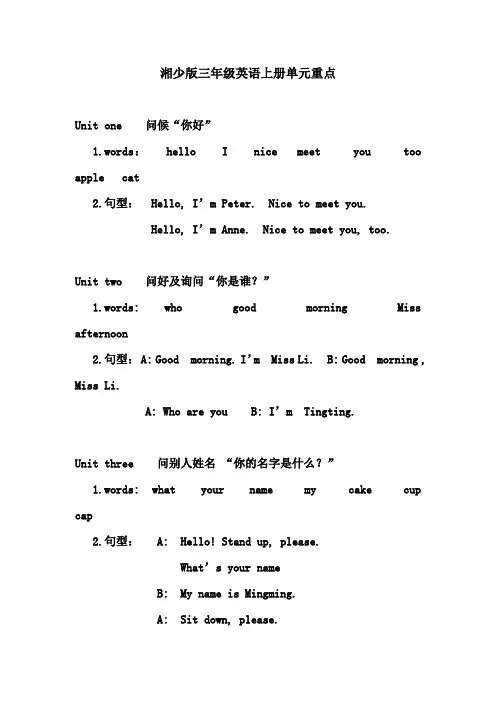
湘少版三年级英语上册单元重点Unit one 问候“你好”1.words: hello I nice meet you too apple cat2.句型: Hello, I’m Peter. Nice to meet you.Hello, I’m Anne. Nice to meet you, too.Unit two 问好及询问“你是谁?”1.words: who good morning Miss afternoon2.句型: A: Good morning. I’m Miss Li. B: Good morning , Miss Li.A: Who are you B: I’m Tingting.Unit three 问别人姓名“你的名字是什么?”1.words: what your name my cake cup cap2.句型: A: Hello! Stand up, please.What’s your nameB: My name is Mingming.A: Sit down, please.Unit four 一般疑问句“Are you…”“你是…吗?”1.words: bag thank welcome boy girlman woman dog duck doll2.句型: Hello, I’m Benny. Are you LinglingYes ,I am. / No, I’m not..Oh, thank you.. You’re welcome.Unit five 询问“他/她是谁”1.words: he she brother sister fathermotherhen nest egg elephant2.句型: Who is he He’s my brother./ He’s my father.Who is she She’s my sister./ She’s my mother.Unit six “ This is my …”“这是我的…” (家庭成员)1.words: this family photo grandfathergrandmother uncle aunt cousin fanfrog friend flower2.句型: This is my family photo.Who’s he He’s my grandfather./ He’s my uncle.Who’s she She’s my grandmother./ She’s my aunt.Unit seven 一般疑问句“Is he/she…”“他是…吗?”1.words: soldier postman nurse teacherdoctor driver fireman policemanpolicewoman pupil2.句型: Is he a soldier No, he isn’t. He’s a postman.Is she a nurse Yes, she is.Unit eight 问职业用“what’s he ”意为“他是做什么的?”1.words:happy hat hot hand girl piggoat grass2.句型: What’s he He’s a fireman.Unit nine “ What is this ”“ This is a …”(身体部位名称)1.words: sorry know nose mouth head hairear eye tooth2.句型: Peter, what is this I am sorry. I don’t know.Anne, do you know This is a nose.Lingling, what is this This is a mouth.Unit ten Touch your head ( 身体部位)1.words: touch raise hand toe leg bodyneck arm foot2.句型: Follow me! Raise your hands.Touch your head.. You’re out..Unit eleven It’s a cow.1.words: cow take card pig duck henmouse2.句型: What is it It’s a cow.Is it a pig Yes, it is ./ No, it isn’t.Unit twelve What’s this1.words: schoolbag in ruler eraser gluepencil-boxapple book pencil sharpener moon mango2.句型: This is my schoolbag.What’s in it A ruler is in it.What’s this It’s a book./ It’s an apple.要求掌握的单词有:(会认,会读,知道意思,能够默写)a an arm bag bird body book boy cat dogduck ear eye foot girl good hand head henleg man name nose pig ruler thank this yes。
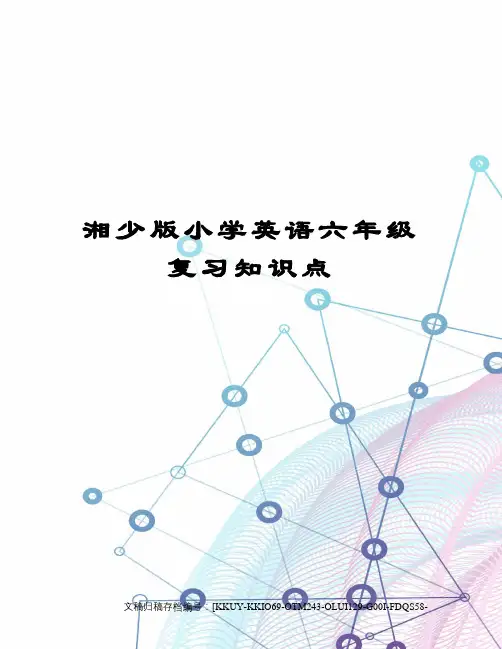
湘少版小学英语六年级复习知识点文稿归稿存档编号:[KKUY-KKIO69-OTM243-OLUI129-G00I-FDQS58-湘少版(湖南少年儿童出版社出版)小学英语教材知识点,使用湘教版小学英语教材六年级(de)老师应该用得着,这些知识点还是很全面(de),希望对您有所帮助.1.字母:(大小)辨认、书写顺序;元音字母:A a , Ee, Ii, Oo, Uu2. 数字:1~999(de)基数词和序数词(de)运用,如计算、购物、时间、日期等.句型:①What's your number②What’s the time③How many pens are there④How old are you⑤How much is it⑥How tall are you⑦How heavy are you⑧What time do you get up⑨When's your birthday⑩What time did you see him3. 颜色:单词:red, pink, yellow, brown, blue, purple, orange, black, white, green.句型:①What colour is it②What’s your favourite colour4. 时间:年、季节、月、星期、日、时刻:Season( spring, summer, autumn, winter)Month: January, February, March, April, May, June, July, August, September, October, November, December.Week:Sunday, Monday, Tuesday, Wednesday, Thursday, Friday, Saturday.Day:1st May (the first of May), May 2nd ( May the second)句型:见话题2.5. 食品与饮料:人对食品与饮料(de)喜好;东西方食品.句型:①I like biscuits.②I’d like a cold drink.③Would you like some buns④Do you want some rice⑤This isn’t my food.6. 服装:服装(de)颜色:人对服装(de)喜好;某人(de)穿戴;所属关系;位置等.句型:①I like the green T-shirt.②Where’s my new cap③Who’s shirt is this④Is this your hat7.物品:名词(de)单、复数;特点、颜色、所属关系;存在(de)位置(in, on, under, beside, behind, in front of, above, near, inside, outside).玩具(toy car, doll, )文具(desk, book, bag ,pen, pencil, pencil-box, ruler, pencil sharpener,)句型:①What’s this②What colour is it③Whose is this④This is my brother’s painting.⑤I have a puppet.⑥There's a car near the hospital.⑦Was it in the wardrobe⑧Is there a book on the desk⑨That's not mine.8.动物和植物:cat, dog, duck, fish, sheep, bird, panda, monkey, rabbit, hen , cock, chick, tiger, lion, pig, cow , mouse (mice), elephant, ladybird, puppy, tree, flower, rose,9. 建筑与场所:factory, hospital, park, house, library, museum, office, farm, post office, bank, police station, railway station, bookstore, school, classroom, skating rink, café, house(ba throom, living-room, sitting-room, bedroom,kitchen),garden…10. 身体:head, hair, eye, nose, ear, mouth, neck, hand, finger, foot(feet) ,toe…外貌: fat, thin, tall, short, old, young, two big blue eyes, long hair, short hair, black hair. 句型:①This is my nose.②Touch your head.③Raise your arm.11. 个人情况:姓名、年龄、地址、特点与爱好.句型:①I'm twelve years old.②My hobby is reading.③I like music.④I'm interested in space.⑤My name is Peter.⑥I'm tall and thin.⑦Do you have any hobbies12. 家庭、亲属和朋友:姓名、年龄、地址、职业、特点与爱好、与你(de)关系family, grandfather(grandpa/granddad), grandmother(grandma/grand mum), father, mother, brother, sister, uncle, aunt, cousin, friend.句型:①Who's heHe's my father.②He's a doctor③He likes playing games.④My father helps me.⑤Is he a soldier⑥What’s he13. 学校:学校建筑和学校生活.school, classroom, library, playground, Chinese, maths , English, music, computer, PE, art, science,句型:①When do you go to school②What time do you have English14. 情绪和身体状态:happy, sad, tired, angry, shy, sorry, well, sick,句型:①I'm sick.②I'm happy.③We are sorry.④ I feel sad.15. 社交礼仪:礼貌用语;询问与应答.句型:问候①Hello./ Hi.②Good morning/afternoon/evening.③How are you ④How do you do⑤Glad to meet you./ Nice to meet you.介绍①My name is…②I’m a pupil.③I’m 12.④This is our teacher, Miss Chen.⑤He is from Japan.道别①Goodbye./Bye.②See you.③Good night.道谢①Thank you./Thanks.②You’re welcome.道歉①Sorry.②I’m sorry.③Excuse me.请求①Can I have a puppy ②Can I borrow a pencil ③Yes, please.④Of course.祝愿①Happy birthday.②Merry Christmas.提供帮助①Can I help you ②What can I do for you ③What’s the matter寻求帮助和建议①What can I do用餐①Do you want some soup ②Would you like some rice ③I'd like a cold drink.购物①Which one do you want ②Can I look at it ③I want a red one, please.④It's too expensive.⑤Have you got enough money⑥How much is it16.国家与国庆日:China, Japan, America (the USA), English( the UK), Australia, Russia, Canada, Singapore, India, France,句型:①When’s your country’s National Day②I come from China.17.天气与气候特征:hot, cold, cool, warm, sun, sunny, rain ,heavy rain, rainy, wind, strong wind,windy, snow , heavy snow, cloud, cloudy, …句型:①What's the weather like②It’s a cold day.③Spring is warm and nice.④Tomorrow will be rainy.⑤I like a sunny day.18. 节日:节日(de)特点;节日(de)活动.New Year's Day, Spring Festival, Children's Day, Mid-autumn Festival, Teachers' Day , National Day, Christmas Day, Dragon Boat Festival.19. 正在发生(de)事情:现在进行(de)动作和发生(de)事.句型:①Are you making a kite②Peter is writing.③What's Anne doing④Where are you going⑤What are they doing⑥Is he running20.日常生活:日常生活、工作、学习(de)活动.句型:①I come to school by bus.②Your homework is good.③What time do you get up④She always get up early.21. 计划与打算:计划和将要进行(de)动作be going to do …句型:①I’m/You’re /He’s/She’s /We’re/They’re (not) going to swim.②Are you going to swim③Is he/she going to visit Anne④What are you going to do⑤What is he going to do⑥When are they going to swim⑦Tomorrow will be rainy.⑧ I'll stay at home.22. 能力和可能:能做某事或可能进行某事.句型:①Can you read and write in English②Can I have a puppy③What can you do④She can run fast.23. 过去发生(de)事情或过去(de)打算:过去式.句型:①Where were you②Who was first③Was it in the wardrobe④Benny took my ball.⑤Where did you go⑥What did you do⑦I came by plane.⑧Anne wanted to skate.24. 对事物(de)比较:比较级和最高级.句型:①My singing is louder than yours.②I’m taller than you.③There more shops in Picture One.④Some stories are more interesting than others.⑤The most interesting stories.⑥Who is fatter25.提醒与告示:①What does that sign mean②Draw a cat on the roof.③Don't put your feet on the seat.④No speaking.⑤Do not go in.26.擅长和喜欢(de)事情:①I'm/ You're/ He's good at drawing.②I like playing basketball.。
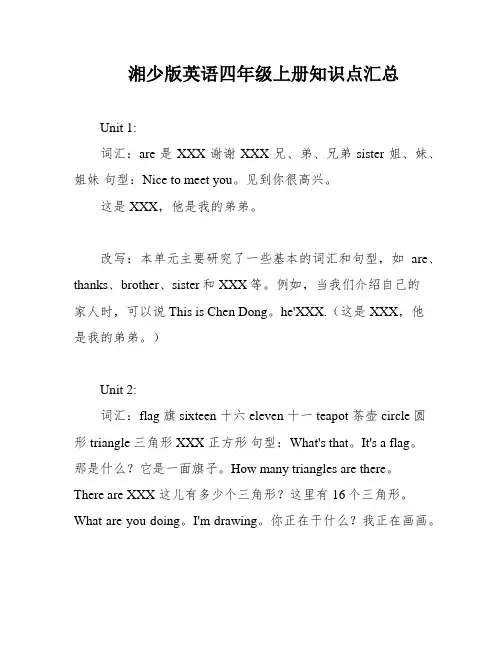
湘少版英语四年级上册知识点汇总Unit 1:词汇:are 是 XXX 谢谢 XXX 兄、弟、兄弟 sister 姐、妹、姐妹句型:Nice to meet you。
见到你很高兴。
这是XXX,他是我的弟弟。
改写:本单元主要研究了一些基本的词汇和句型,如are、thanks、brother、sister和XXX等。
例如,当我们介绍自己的家人时,可以说This is Chen Dong。
he'XXX.(这是XXX,他是我的弟弟。
)Unit 2:词汇:flag 旗 sixteen 十六 eleven 十一 teapot 茶壶 circle 圆形 triangle 三角形 XXX 正方形句型:What's that。
It's a flag。
那是什么?它是一面旗子。
How many triangles are there。
There are XXX 这儿有多少个三角形?这里有16个三角形。
What are you doing。
I'm drawing。
你正在干什么?我正在画画。
改写:在本单元中,我们研究了一些形状的词汇,如flag、circle、XXX和XXX等。
我们也学会了一些用来询问和回答的句型,例如What's that?(那是什么?)和I'm drawing.(我正在画画。
)Unit 3:词汇:XXX 大象 big 大的 small 小的 XXX 猴子 XXX 老虎 naughty 调皮的 strong 强壮的 beautiful 美丽 lazy 懒惰的句型:Look XXX。
看那只大象。
Look at this bird。
It's beautiful。
看这只鸟。
它很漂亮。
Is that right。
Yes。
it is./ No。
it isn't。
那是对的吗?是的。
/不是的。
改写:在本单元中,我们研究了一些动物的词汇,如elephant、XXX和XXX等。
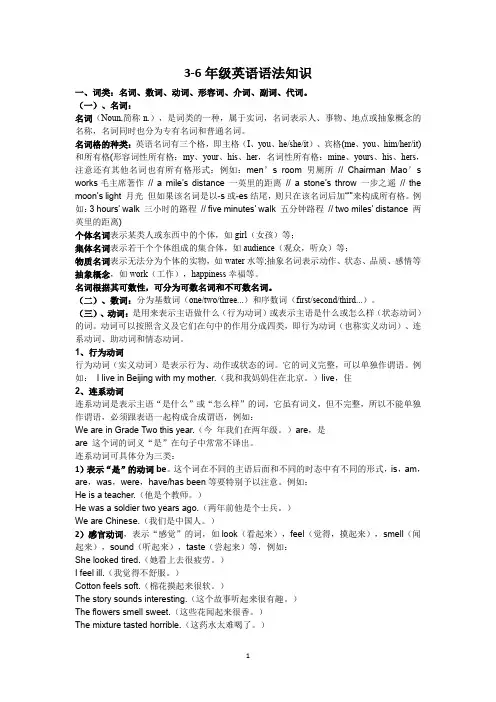
3-6年级英语语法知识一、词类:名词、数词、动词、形容词、介词、副词、代词。
(一)、名词:名词(Noun,简称n.),是词类的一种,属于实词,名词表示人、事物、地点或抽象概念的名称,名词同时也分为专有名词和普通名词。
名词格的种类:英语名词有三个格,即主格(I、you、he/she/it)、宾格(me、you、him/her/it)和所有格(形容词性所有格:my、your、his、her,名词性所有格:mine、yours、his、hers,注意还有其他名词也有所有格形式:例如:men’s room 男厕所// Chairman Mao’s works毛主席著作// a mile’s distance 一英里的距离// a stone’s throw 一步之遥// the moon’s light 月光但如果该名词是以-s或-es结尾,则只在该名词后加“’”来构成所有格。
例如:3 hours’ walk 三小时的路程// five minutes’ walk 五分钟路程// two miles’ distance 两英里的距离)个体名词表示某类人或东西中的个体,如girl(女孩)等;集体名词表示若干个个体组成的集合体,如audience(观众,听众)等;物质名词表示无法分为个体的实物,如water水等;抽象名词表示动作、状态、品质、感情等抽象概念,如work(工作),happiness幸福等。
名词根据其可数性,可分为可数名词和不可数名词。
(二)、数词:分为基数词(one/two/three...)和序数词(first/second/third...)。
(三)、动词:是用来表示主语做什么(行为动词)或表示主语是什么或怎么样(状态动词)的词。
动词可以按照含义及它们在句中的作用分成四类,即行为动词(也称实义动词)、连系动词、助动词和情态动词。
1、行为动词行为动词(实义动词)是表示行为、动作或状态的词。
它的词义完整,可以单独作谓语。
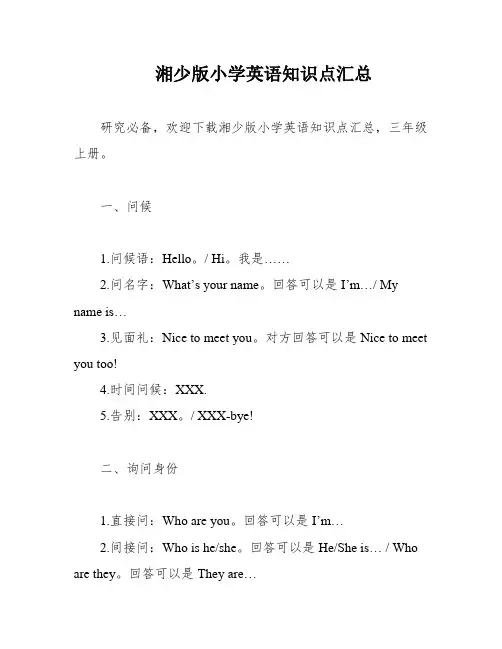
湘少版小学英语知识点汇总研究必备,欢迎下载湘少版小学英语知识点汇总,三年级上册。
一、问候1.问候语:Hello。
/ Hi。
我是……2.问名字:What’s your name。
回答可以是I’m…/ My name is…3.见面礼:Nice to meet you。
对方回答可以是Nice to meet you too!4.时间问候:XXX.5.告别:XXX。
/ XXX-bye!二、询问身份1.直接问:Who are you。
回答可以是I’m…2.间接问:Who is he/she。
回答可以是He/She is… / Who are they。
回答可以是They are…三、选择疑问句(是不是?)1.直接问:Are you…。
回答可以是Yes。
I am。
/ No。
I’m not.2.间接问:Is he/she…。
回答可以是Yes。
he/she is。
/ No。
he/she isn’t。
/ Are they…。
回答可以是Yes。
they are。
/ No。
they aren’t.四、介绍1.介绍家庭成员:This is my family。
询问可以是Is this your family。
回答可以是Yes。
it is。
/ No。
it isn’t.五、问身份1.直接问:XXX。
回答可以是XXX.What are they。
They are pupils。
XXX.Is he/she a soldier。
Yes。
he/she is。
/ No。
he/she isn't.Are they pupils。
Yes。
they are。
/ No。
they aren't.XXX。
It's a。
What are these/those。
These/Those are。
Personal pronouns: I。
you。
he/she/it。
we。
you。
they.Be verbs: is (singular)。
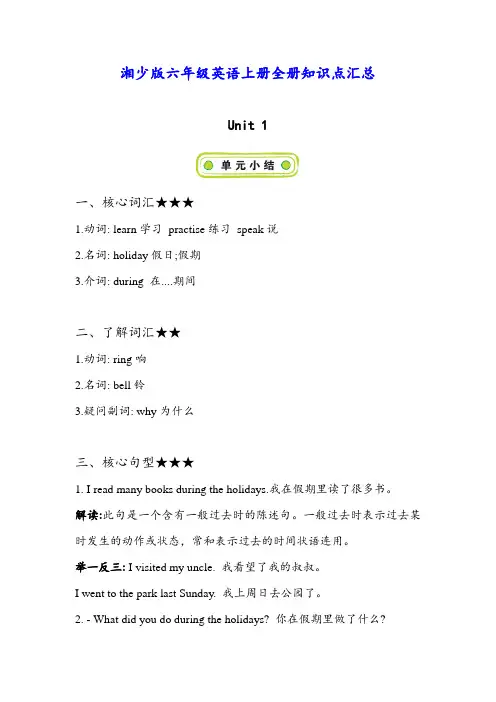
湘少版六年级英语上册全册知识点汇总Unit 1一、核心词汇★★★1.动词: learn学习practise练习speak说2.名词: holiday假日;假期3.介词: during 在....期间二、了解词汇★★1.动词: ring响2.名词: bell铃3.疑问副词: why为什么三、核心句型★★★1. I read many books during the holidays.我在假期里读了很多书。
解读:此句是一个含有一般过去时的陈述句。
一般过去时表示过去某时发生的动作或状态,常和表示过去的时间状语连用。
举一反三: I visited my uncle. 我看望了我的叔叔。
I went to the park last Sunday. 我上周日去公园了。
2. - What did you do during the holidays? 你在假期里做了什么?- I learnt writing. 我学习写作了。
解读:问句是一般过去时的特殊疑问句。
答语为一般过去时的陈述句。
举一反三: - What did you do yesterday? 你昨天做什么了?- I played with my friends. 我和我的朋友们玩了。
3. Why didn't you run around the tree? 你为什么不绕着树跑?解读:此句是一个一般过去时的特殊疑问句,why为特殊疑问词,意为“为什么”,用于向对方询问原因,一般要用“Because ..”来回答。
举一反三: Why didn't you go out to play? 你为什么没有出去玩?四、了解句型★★1,The students are talking about their holidays.学生们正在讨论他们的假期。
解读:此句是一个现在进行时的陈述句。
现在进行时表示正在进行或发生的动作。
举一反三: He is watching TV.他正在看电视。
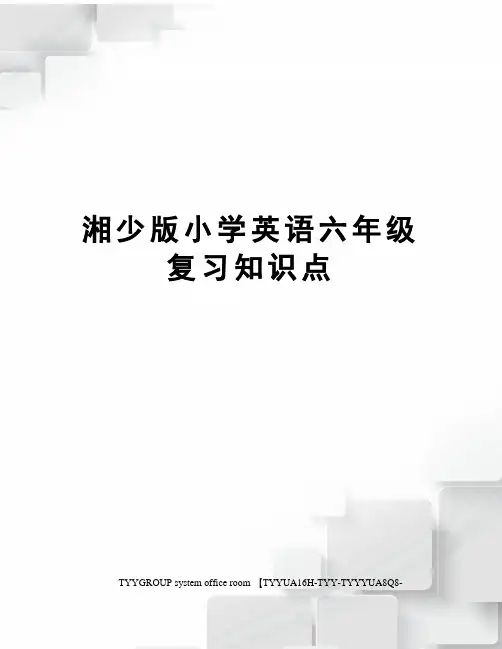
湘少版小学英语六年级复习知识点TYYGROUP system office room 【TYYUA16H-TYY-TYYYUA8Q8-湘少版(湖南少年儿童出版社出版)小学英语教材知识点,使用湘教版小学英语教材六年级的老师应该用得着,这些知识点还是很全面的,希望对您有所帮助。
1.字母:(大小)辨认、书写顺序;元音字母:A a , Ee, Ii, Oo, Uu2. 数字:1~999的基数词和序数词的运用,如计算、购物、时间、日期等。
句型:①What's your number?②What’s the time?③How many pens are there?④How old are you?⑤How much is it?⑥How tall are you?⑦How heavy are you⑧What time do you get up?⑨When's your birthday?⑩What time did you see him?3. 颜色:单词:red, pink, yellow, brown, blue, purple, orange, black, white, green.句型:①What colour is it②What’s your favourite colour?4. 时间:年、季节、月、星期、日、时刻:Season( spring, summer, autumn, winter)Month: January, February, March, April, May, June, July, August, September, October, November, December.Week:Sunday, Monday, Tuesday, Wednesday, Thursday, Friday, Saturday. Day:1st May (the first of May), May 2nd ( May the second)句型:见话题2。
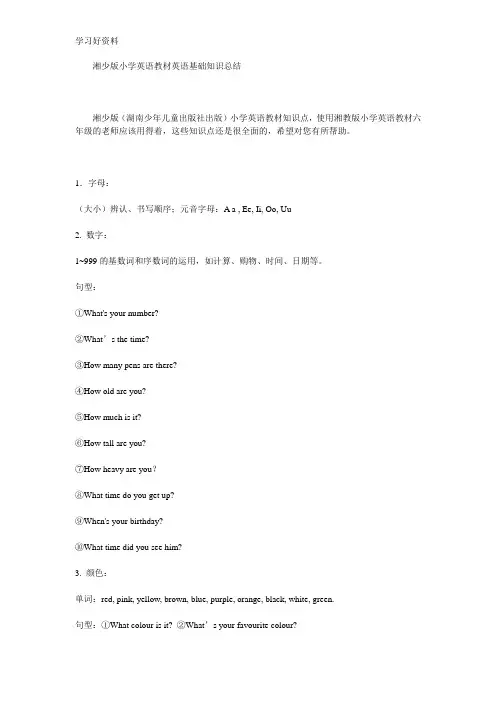
湘少版小学英语教材英语基础知识总结湘少版(湖南少年儿童出版社出版)小学英语教材知识点,使用湘教版小学英语教材六年级的老师应该用得着,这些知识点还是很全面的,希望对您有所帮助。
1.字母:(大小)辨认、书写顺序;元音字母:A a , Ee, Ii, Oo, Uu2. 数字:1~999的基数词和序数词的运用,如计算、购物、时间、日期等。
句型:①What's your number?②What’s the time?③How many pens are there?④How old are you?⑤How much is it?⑥How tall are you?⑦How heavy are you?⑧What time do you get up?⑨When's your birthday?⑩What time did you see him?3. 颜色:单词:red, pink, yellow, brown, blue, purple, orange, black, white, green.句型:①What colour is it? ②What’s your favourite colour?4. 时间:年、季节、月、星期、日、时刻:Season( spring, summer, autumn, winter)Month: January, February, March, April, May, June, July, August, September, October, November, December.Week: Sunday, Monday, Tuesday, Wednesday, Thursday, Friday, Saturday.Day: 1st May (the first of May), May 2nd ( May the second)句型:见话题2。
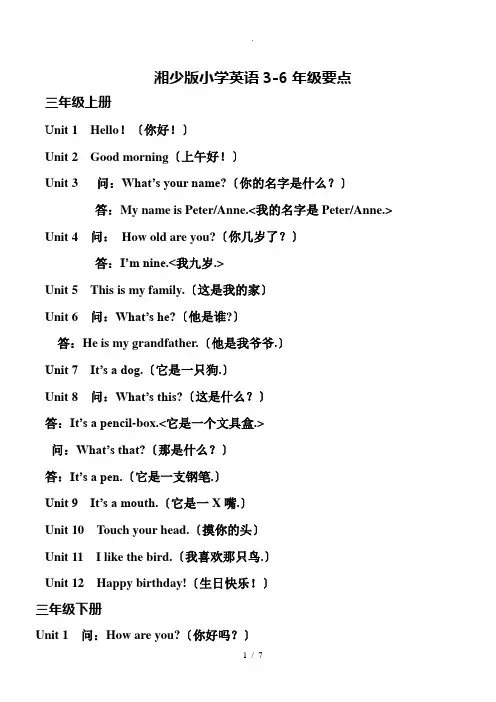
湘少版小学英语3-6年级要点三年级上册U nit 1 Hello!〔你好!〕Unit 2 Good morning〔上午好!〕Unit 3 问:What’s your name?〔你的名字是什么?〕答:My name is Peter/Anne.<我的名字是Peter/Anne.> Unit 4 问:How old are you?〔你几岁了?〕答:I’m nine.<我九岁.>Unit 5 This is my family.〔这是我的家〕Unit 6 问:What’s he?〔他是谁?〕答:He is my grandfather.〔他是我爷爷.〕Unit 7 It’s a dog.〔它是一只狗.〕Unit 8 问:What’s this?〔这是什么?〕答:It’s a pencil-box.<它是一个文具盒.>问:What’s that?〔那是什么?〕答:It’s a pen.〔它是一支钢笔.〕Unit 9 It’s a mouth.〔它是一X嘴.〕Unit 10 Touch your head.〔摸你的头〕Unit 11 I like the bird.〔我喜欢那只鸟.〕Unit 12 Happy birthday!〔生日快乐!〕三年级下册Unit 1 问:How are you?〔你好吗?〕答:I’m fine ,thank you.〔我好,谢谢你.〕Unit 2 问:Are you Lingling?〔你是玲玲吗?〕答:Yes,I am./No, I’m not.<是的,我是/不是的,我不是.>Unit 3 问:What color is this balloon?〔这个气球是什么颜色?〕答:It’s blue/pink.<它是蓝色/粉色.>Unit 4 Look at the T-shirts.〔看这件T恤衫.〕Unit 5 问:What time is it?〔几点钟了?〕答:It’s seven o’clock. /Sorry, I don’t know.<7点/对不起,我不知道.> Unit 6 问:How many pens are there?〔有几只钢笔?〕答:Four pens.<四只钢笔.>Unit 7 问:Is this an orange?.〔这是一个橘子吗?〕答:Yes,it is./No,it isn’t.<是的,它是./不是的,它不是.>Unit 8 I like a sunny day.〔我喜欢晴天〕Unit 9 问:What’s the weather like?〔天气怎样?〕答:It’s raining.<在下雨.>Unit 10 问:Is he a farmer?〔他是一个农民吗?〕答:Yes, h e is /No, he isn’t.<是的,他是./不是的,他不是.>Unit 11 问:What’s he?〔他是干什么的?〕答:He is a postman/teacher/policeman/farmer/pupil/fireman.〔他是邮递员/教师/警察/农民/小学生/消防员〕Unit 12 问:How do you go to school? 你怎样来学校?答: I e to school by bus.〔我坐公交车来学校.〕四年级上册Unit 1 Nice to meet you.〔见到你很高兴!〕Unit 2 It’s a circle.〔它是一个圆.〕Unit 3 Look at this elephant.〔看这只象.〕Unit 4 These are flowers.〔这些是花.〕Unit 5 I like noodles.〔我喜欢面条.〕Unit 6 Turn right.〔向右转.〕Unit 7 问:Whose is this?〔这是谁的?〕答:It’s my wallet.〔它是我的钱包.〕Unit 8 She wears a white and black sweater.〔她穿白黑相间的毛衣.〕Unit 9 It’s one hundred.〔它是一百〕Unit 10 Wele to our home.〔欢迎来我们的家〕Unit 11 问:Where’s the cat?〔猫在哪里?〕答:She’s in the kitchen.〔她在厨房.〕Unit 12 Peter can jump high.〔Peter 能跳高.〕四年级下册Unit 1 问:Where is my cap? 我的帽子在哪里?答:It’s on your head!〔它在你的头上.〕Unit 2 Spring is warm.〔春天暖和.〕Unit 3 问:What can you see?〔你能看见什么?〕答:I can see a river/a lake/a boat/the blue sky/white clouds/.〔我能看见一条小河/一个湖/蓝色天空/白云.〕Unit 4 问:Can you write in English?〔你能用英语写吗?〕答:Yes, I can./ No, I can’t.〔是的,我能./ 不是的,我不能.〕Unit 5 Peter is writing.〔Peter 在写字.〕Unit 6 问:What’s Anne doing?〔Anne 在做什么?〕答:She is skipping.〔她在跳绳.〕Unit 7 问:What day is today? 今天星期几?答:Today is Saturday.〔今天是星期六.〕Unit 8 问:Where are you from?〔你从哪里来?你是哪里人?〕答:I e from China.〔我来自中国. 我是中国人.〕Unit 9 问:How much is it?〔它多少钱?〕答:It’s fifty-six yuan.〔它是56元.〕Unit 10 He has two feet.〔他有两只脚.〕Unit 11 问:Do you have a ticket?〔你有票吗?〕答:Yes,I do./No, I don’t.〔是的,我有./不,我没有.〕Unit 12 问:Do you have any money?〔你有钱吗?〕答:Yes, I have two yuan.〔是的,我有两元.〕五年级上册Unit 1 问:What does she look like?〔她看起来怎样?〕答:She has short hair and small eyes. She is beautiful.〔她有短发和小眼睛,她很漂亮.〕Unit 2 问:What would you like ?〔你想要什么?〕答:I’d like a hamburger.〔我想要汉堡包.〕Unit 3 问:Do you want some rice?〔你想要吃米饭吗?〕答:Yes, please./No,thank you.〔是的,请来一些.〕〔不,谢谢你.〕Unit 4 问:Can I use your pencil, please?〔请问我能用你的铅笔吗?〕答:Yes, here you are.〔可以,给你.〕Unit 5 问:Can I have a pet?〔我可以养宠物吗?〕答:Yes, you can./No, you can’t.〔是的,你可以.〕〔不,你不能.〕Unit 6 问:Which one do you want?〔你想要哪一个?〕答:I want the thick one.〔我想要厚的这一件.〕Unit 7 问:What time do you get up?〔你几点起床?〕答:I get up at 6:50.〔我六点五十起床.〕Unit 8 Lingling helps her parents.〔玲玲帮助她的父母.〕Unit 9 问:What’s your hobby?〔你的业余爱好是什么?〕答:My hobby is reading.〔我的爱好是读书.〕Unit 10 问:What does that sign mean?〔这个标志是什么意思?〕答:It means "You can go out from there .〞〔它的意思是"你可以从那儿出去.〞〕Unit 11 I’m sorry./I feel sorry. 〔对不起/我觉得不好意思.〕Unit 12 The Spring Festival.〔春节〕Children wear new clothes.〔孩子们穿新衣服.〕五年级下册Unit 1 We are going to read stories.〔我将要读故事.〕Unit 2 We are going to do some research.〔我们将要做一些调查.〕Unit 3 Let’s make a kite.〔让我们做风筝吧.〕Unit 4 Don’t talk here.〔不要在这里讲话.〕Unit 5 问:W hen’s your birthday?〔你的生日是什么时候?〕答:My birthday is in March./It’s on the fifth of March.〔我的生日在三月.〕〔我的生日在3月5日.〕Unit 6 I’ll make a beautiful card.〔我将要做一X漂亮的卡片.〕Unit 7 问:Is there a post office near my school?〔我的学校附近有一个邮局吗?〕答:Yes ,there is./No,there isn’t.〔是的,有./不,没有.〕Unit 8 问:Can you show me the way to the Xinhua hotel?〔你能告诉我到新华旅社的路吗?〕答:Y ou can go straight along this road.〔你可以沿着这条路直走.〕Unit 9 He’s kind to children.〔他对孩子们好.〕Unit 10 问:Where were you yesterday?〔昨天你在哪里?〕答:I was at work.〔我在工作.〕Unit 11 问:Who was first?〔谁第一?〕答:Amy was first.〔艾米第一.〕Unit 12 问:Where did you go?〔你们去过哪里?〕答:We went to the park.〔我们去过公园.〕六年级上册Unit 1 问:What did you do during the holidays?〔假日你做了什么?〕答:I read many books/We watched TV.〔我读了书/我们了看电视.〕Unit 2 Katie always gets up early.〔Katie总是起床早.〕Unit 3 问:What do you like ? 你喜欢什么?答:I like my puter.〔我喜欢电脑.〕Unit 4 The Mid-Autumn Festivals is ing.〔中秋节要来了.〕Unit 5 It will be sunny and cool tomorrow.〔明天天气将晴朗又凉爽.〕Unit 6 问:What will you bring for the piic?野炊你将带什么?答:I will bring a big bottle of orange juice.〔我将带一大瓶橘子汁.〕Unit 7 问:What can you do?〔你能做什么?〕答:I can ask Mun to make cakes for them. 我可以要妈妈给他们做蛋糕. Unit 8 We shouldn’t waste water.〔我们不应该浪费水.〕Unit 9 This bird is bigger than the first one.〔这只鸟比第一只鸟大些.〕Unit 10 问:What’s wrong with you? 你怎么啦?答:I have a fever. 我发烧问:What’s wrong with you today? 你今天怎么啦?答:I don’t feel well today.〔今天我觉得不舒服.〕Unit 11 问:Shall we go to the theatre?〔我们将去剧院吗?〕答:Well,it’s a good idea.〔好,这是一个好主意.〕Unit 12 It’s Christmas again!〔圣诞节又到了!〕六年级下册Unit 1 A family outing.〔家庭旅游.〕Unit 2 Some stories are more interesting.〔有些故事更有趣.〕Unit 3 We should learn to take care of ourselves.〔我们应该学会照顾好自己.〕Unit 4 Planting trees is good for us.〔植树对我们有好处.〕Unit 5 Our Earth looks like this in space.〔我们的地球在太空中象这个样子.〕Unit 6 Anne wanted to dance.〔Anne想要跳舞.〕Unit 7 I’m not afraid.〔我不害怕.〕Unit 8 International Children’s Day.〔国际六一儿童节.〕Unit 9 Look at these beautiful places in the world.〔看世界上这些漂亮的地方.〕。
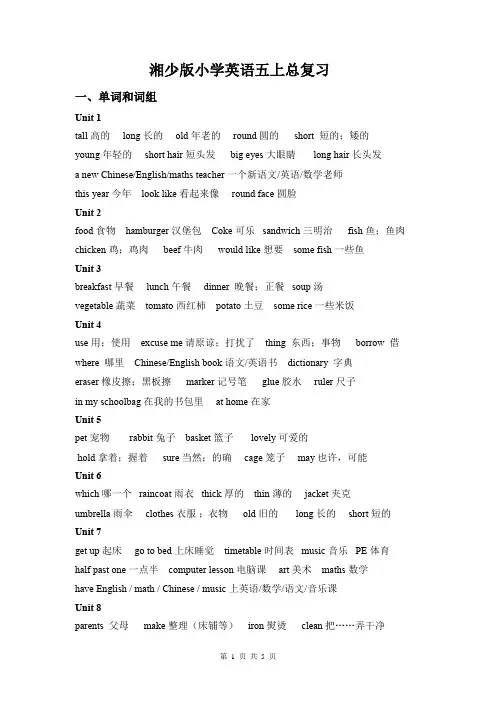
湘少版小学英语五上总复习一、单词和词组Unit 1tall高的long长的old年老的round圆的short 短的;矮的young年轻的short hair短头发big eyes大眼睛long hair长头发a new Chinese/English/maths teacher一个新语文/英语/数学老师this year今年look like看起来像round face圆脸Unit 2food食物hamburger汉堡包Coke可乐sandwich三明治fish鱼;鱼肉chicken鸡;鸡肉beef牛肉would like想要some fish一些鱼Unit 3breakfast早餐lunch午餐dinner 晚餐;正餐soup汤vegetable蔬菜tomato西红柿potato土豆some rice一些米饭Unit 4use用;使用excuse me请原谅;打扰了thing东西;事物borrow借where哪里Chinese/English book语文/英语书dictionary 字典eraser橡皮擦;黑板擦marker记号笔glue胶水ruler尺子in my schoolbag在我的书包里at home在家Unit 5pet宠物rabbit兔子basket篮子lovely可爱的hold拿着;握着sure当然;的确cage笼子may也许,可能Unit 6which哪一个raincoat雨衣thick厚的thin薄的jacket夹克umbrella雨伞clothes衣服;衣物old旧的long长的short短的Unit 7get up起床go to bed上床睡觉timetable时间表music音乐PE体育half past one一点半computer lesson电脑课art美术maths数学have English / math / Chinese / music上英语/数学/语文/音乐课Unit 8parents 父母make整理(床铺等)iron熨烫clean把……弄干净meal一餐water给……浇水plant植物wash洗her她(she的宾格)him他(he的宾格)make the bed整理床铺cook a meal做饭sweep the floor 扫地water the plants给植物浇水iron the clothes熨烫衣服clean the windows擦窗户wash the vegetables洗蔬菜Unit 9hobby爱好take拍(照);摄(影)photos照片(photo的复数)collect收集stamp邮票storybook故事书violin小提琴chess象棋collecting stickers收集贴纸collecting stamps集邮collecting old photos收集老照片collecting storybooks收集故事书playing chess下棋playing the violin拉小提琴taking photos拍照片reading阅读Unit 10sign标志mean表示……的意思cinema电影院talk说话fish钓鱼pick摘smoke吸烟spit吐痰Unit 11sorry抱歉的;难过的happy高兴的,开心的angry生气的;发怒的noisy 嘈杂的;喧闹的loudly大声地sad悲伤的shy害羞的noise噪音unhappy不开心的proud骄傲的excited兴奋的make a lot of noise制造了很多噪音Unit 12house房子eve前夜delicious好吃的enjoy喜爱;享受firecracker爆竹;鞭炮have great fun过得很愉快red packets红包the Spring Festival春节eve of the Spring Festival除夕夜lion dance舞狮light firecrackers放鞭炮dragon dance舞龙 a family reunion dinner团圆饭二、句型Unit 1Unit 21. -What would you like?你想要什么?-I’d like a hamburger.我要一个汉堡包。
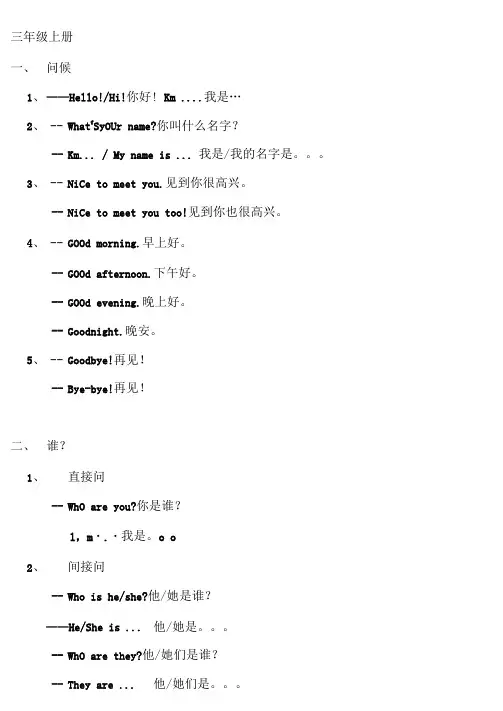
三年级上册一、问候1、——Hello!/Hi!你好! Km ....我是…2、-- What f SyOUr name?你叫什么名字?-- Km... / My name is ... 我是/我的名字是。
3、-- NiCe to meet you.见到你很高兴。
-- NiCe to meet you too!见到你也很高兴。
4、-- GOOd morning.早上好。
-- GOOd afternoon.下午好。
-- GOOd evening.晚上好。
-- Goodnight.晚安。
5、-- Goodbye!再见!-- Bye-bye!再见!二、谁?1、直接问-- WhO are you?你是谁?l,m・.・我是。
o o2、间接问-- Who is he/she?他/她是谁?——He/She is ... 他/她是。
-- WhO are they?他/她们是谁?-- They are ... 他/她们是。
三、选择疑问句(是不是?)①直接问-- Are you ...? 你是。
吗?-- Yes, I am. / No, Γm not.是,我是。
/ 不,我不是。
②间接问-- IS he/she ...?他/她是。
吗?-- Yes, he/she is. / No, he/she isn,t.是,他/她是。
/ 不,他/她不是。
-- Are they...?他/她们是… 吗?-- Yes, they are. / No, they aren,t.是,他们是。
/ 不,他们不是。
四、介绍(ThiSis・・・)①介绍家庭成员-- ThiS is my family.这是我的家庭。
②提问-- IS this your family? 这是你的家庭吗?-- Yes, it is. / No, it isn,t.是,它是。
/ 不,它不是。
五、问身份①直接问-- What,s he/she?他/她是什么?-- He/She is a fireman・他/她是消防员。
Unit 1 It is on your head!一、过关单词:cap(有帽檐的)帽子beside在……旁边between在……中间behind在……后面watch 手表answer 回答shoes鞋new新的glasses眼镜under 在……下面on 在……上面in在……里面二、过关句型:1.Where’s my new cap? 我的新帽子在那里?2.It is on your head. 在你的头上。
3.It is on the bed.在床上4.It is under the bed.在床下5.It is behind the door. 在门后面6.Where are my glasses? 我的眼镜在哪里?7.They are in your bag.在你的书包里。
8.They are beside the books.在你的书旁边。
9.They are between the caps.在帽子的中间。
三、过关知识点:1.区分介词:on(在...上面),in(在...里面),under(在...下面),behind(在...后面)beside(在...旁边)between(在...中间)2.区分where is ....? 和where are....? 及相应的回答。
注释:where is 表达单数概念,“一个... 在哪里?”,如:where is my blue shirt, Mum? (妈妈,我的蓝色衬衫在哪里?) 强调只有一件。
回答用:It is ... 如:It is on my head.(它在我头上。
)Where are 表达复数概念,“两个(以上)... 在哪里?”,如:where are my brown shoes, Mum?(妈妈,我的鞋子在哪里?) 鞋子有两只,强调两个(及以上)数量。
回答用:They are ... 如:They are under the chair.(它们在椅子下。
三年级上册问候1、------Hello! / Hi! 你好!I’m …. 我是。
2、------What’s your name? 你叫什么名字?------I’m…/ My name is …我是/我的名字是。
3、------Nice to meet you. 见到你很高兴。
-----Nice to meet you too! 见到你也很高兴。
4、------Good morning. 早上好。
------Good afternoon. 下午好。
------Good evening. 晚上好。
------Goodnight. 晚安。
5、------Goodbye! 再见!------Bye-bye! 再见!谁?直接问------Who are you? 你是谁?------I’m …我是。
间接问------Who is he/she? 他/她是谁?-----He/She is …他/她是。
------Who are they? 他/她们是谁?------They are …他/她们是。
选择疑问句(是不是?)○1直接问------Are you …? 你是。
吗?------Yes, I am. / No, I’m not. 是,我是。
/ 不,我不是。
○2间接问------Is he/she …? 他/她是。
吗?------Yes, he/she is. / No, he/she isn’t. 是,他/她是。
/ 不,他/她不是。
------Are they …? 他/她们是。
吗?------Yes, they are. / No, they aren’t. 是,他们是。
/ 不,他们不是。
四、介绍(This is …)○1介绍家庭成员------This is my family. 这是我的家庭。
○2提问------Is this your family?这是你的家庭吗?------Yes, it is. / No, it isn’t. 是,它是。
三年上册一、候1、------Hello! / Hi!你好!I ’m ⋯.我是。
2、------What’s your name?你叫什么名字?------I’m⋯/ My name is⋯我是 /我的名字是。
3、------Nice to meet you.到你很高。
------Nice to meet you too!到你也很高。
4、------Good morning.早上好。
------Good afternoon.下午好。
------Good evening.晚上好。
------Goodnight.晚安。
5、------Goodbye!再!------Bye-bye!再!二、?1、直接------Who are you?你是?------I’m⋯ 我是。
2、接------Who is he/she? ------He/She is ⋯ ------Who are they? ------They are ⋯他/ 她是?他/ 她是。
他/ 她是?他/ 她是。
三、疑句(是不是?)○1直接------Are you⋯?你是。
?------Yes, I am. / No, I’m not.是,我是。
/不,我不是。
○2接------Is he/she⋯ ? 他/ 她是。
?------Yes, he/she is. / No, he/she isn’t. 是,他 / 她是。
/不,他 /她不是。
------Are they⋯?他/她是。
?------Yes, they are. / No, they aren’t.是,他是。
/不,他不是。
四、介(This is⋯)○1介家庭成------This is my family.是我的家庭。
○2提------Is this your family?是你的家庭?------Yes, it is. / No, it isn’t.是,它是。
/不,它不是。
五、身份○1直接------What ’s he/she?他/ 她是什么?------He/She is a fireman.他/ 她是消防。
湘少版小学英语知识点归纳集锦湘少版小学英语知识点归纳集锦一、人称代词教学篇章知识点归纳:人称代词你我他她它,主格宾格要分清,单数复数也要记牢。
I,me我我我,we,us是我们。
You,you你、你们都用它。
She,her女生她,he,him男生他,it,it宝盖头它。
They,them他她它们都是它。
做题法则要记牢:动前主格,动后宾,介词宾语用宾格。
二、动词一般现在时教学篇章知识点归纳动词一般现在时,经常发生成习惯,客观现实在其中,普遍真理是成员。
做题法则要记牢:第三人称单数不能忘,be动词(am,is,are)三种形式要用对,其它人称一律动词原。
三、物主代词教学篇章知识点归纳物主代词分两派,形物代与名物代。
中文意思很好记:你的我的他她他的。
单数复数要分清。
my,mine是我的;our,ours我们的。
Your,yours你的你们的。
His,his男他的,her,hers女她的,its,its宝盖头它的;their.theirs他她它(们)的。
物主代词的做题技巧:物主代词分两种:形物代与名物代,做题法则要记牢:形物代,后有名词紧相随;名物代可做主语和宾语,后面不能接名词;动词前面做主语,动词后面做宾语,通常一人打天下。
四、英语句型转换专题分析A一般疑问句的句型转换和问答(一)提前单词到句首的一般疑问句1、句中有be动词am,is are,was,were,分别提前它们到句首。
2、句中有can,could,will,would,shall等情态动词,分别提前它们到句首。
3、have/has/had got句式的陈述句,分别提前have/has/had 到句首。
(二)借助助动词do/does/did的一般疑问句1、陈述句的肯定句中不存在提前的单词。
2、助动词do/does/did的选择是由原句中的谓语动词的形式来确定的。
3、借助了助动词以后,句子中主语后的谓语动词必须回复原形。
4、谓语动词是do/does/did的陈述句,do/does/did在句中是实意动词“做”或者“干”的意思。
湘少版小学英语知识点归纳集锦
一、人称代词教学篇章知识点归纳:
人称代词你我他她它,主格宾格要分清,单数复数也要记牢。
I,me 我我我,we,us 是我们。
You,you你、你们都用它。
She,her女生她, he,him男生他,it,it宝盖头它。
They,them他她它们都是它。
做题法则要记牢:动前主格,动后宾,介词宾语用宾格。
二、动词一般现在时教学篇章知识点归纳
动词一般现在时,经常发生成习惯,客观现实在其中,普遍真理是成员。
做题法则要记牢:第三人称单数不能忘,be动词(am,is,are三种形式要用对,其它人称一律动词原。
三、物主代词教学篇章知识点归纳
物主代词分两派,形物代与名物代。
中文意思很好记:你的我的他她他的。
单数复数要分清。
my,mine是我的;our,ours我们的。
Your,yours你的你们的。
His,his男他的,her,hers女她的,its,its宝盖头它的;their.theirs他她它(们的。
物主代词的做题技巧:物主代词分两种:形物代与名物代,做题法则要记牢:形物代,后有名词紧相随;名物代可做主语和宾语,后面不能接名词;动词前面做主语,动词后面做宾语,通常一人打天下。
四、英语句型转换专题分析
A一般疑问句的句型转换和问答
(一提前单词到句首的一般疑问句
1、句中有be动词am,is are,was,were,分别提前它们到句首。
2、句中有can,could,will,would,shall等情态动词,分别提前它们到句首。
3、have/has/had got句式的陈述句,分别提前have/has/had到句首。
(二借助助动词do/does/did的一般疑问句
1、陈述句的肯定句中不存在提前的单词。
2、助动词do/does/did的选择是由原句中的谓语动词的形式来确定的。
3、借助了助动词以后,句子中主语后的谓语动词必须回复原形。
4、谓语动词是do/does/did的陈述句,do/does/did在句中是实意动词“做”或者“干”的意思。
B一般疑问句,转换分两种:提前和借助。
做题先找找提前词语有没有。
没有必须要借助,借助动词要选对,谓语动词是参照。
动词原形借助do,第三人称单数用does,过去式用did.借助以后不要忘,主语后面的谓语动词一律要还原。
C一般疑问句的回答知识点归纳
Yes,Yes,No,No,No.答语的人称代词要用对,问一般疑问句,肯定回答用Yes,否定回答要用No.问你(you 我(I来答,问我(I你(you来答,问他她它,还是他她它来答。
男生he,女生she,宝盖头它用it。
单数问,单数答;复数问,复数答。
句首词,很重要,回答必须要用上。
用什么问,用什么答。
但是Are you …?回答有点小变化。
肯定回答Yes,I am.否定回答No,I’m not
五、小学英语毕业复习题型分析
(一连词成句
1、看标点符号,确定句子类型(是疑问句还是陈述句
2、找固定句式(there be, let’s+动词原,want to+动词原, have/has/had got, would like, good at ,等等
a.祈使句使用动词原要牢记
b.be+形容词
c.let’s+动词原
d.No+动词ing
e.Don’t +动词原
3、找固定的短语或者习惯用语。
4、连词成句
a..按照固定句式的句子结构连词成句。
b.遵从陈述句的句子结构,某人做事在何时何地连词成句。
5、朗读句子并理解。
六、用所给词的正确形式填空题型做题步骤与技巧
1、看所给词的词性是什么
a.所给词为名词:一看可数还是不可数;二看单数还复数;三看复数的正确变化形式。
b.所给词为动词:一确定时态;二看是不是惯用法;三看前面是否有情态动词
c.所给词是数词:判断是基数词还是序数词。
前有定冠词the 的,通常为序数词。
后面的名词为可数名词复数形式的通常为基数词。
d.所给的词为形容词:一看是原型还是比较级或者最高级;二看用形容词本身还是要转换成副词。
e.所给词是代词:一判断是人代还是物代;二人代用主格还是用宾格,物代用名物代还是形物代;三是单数还是复数。